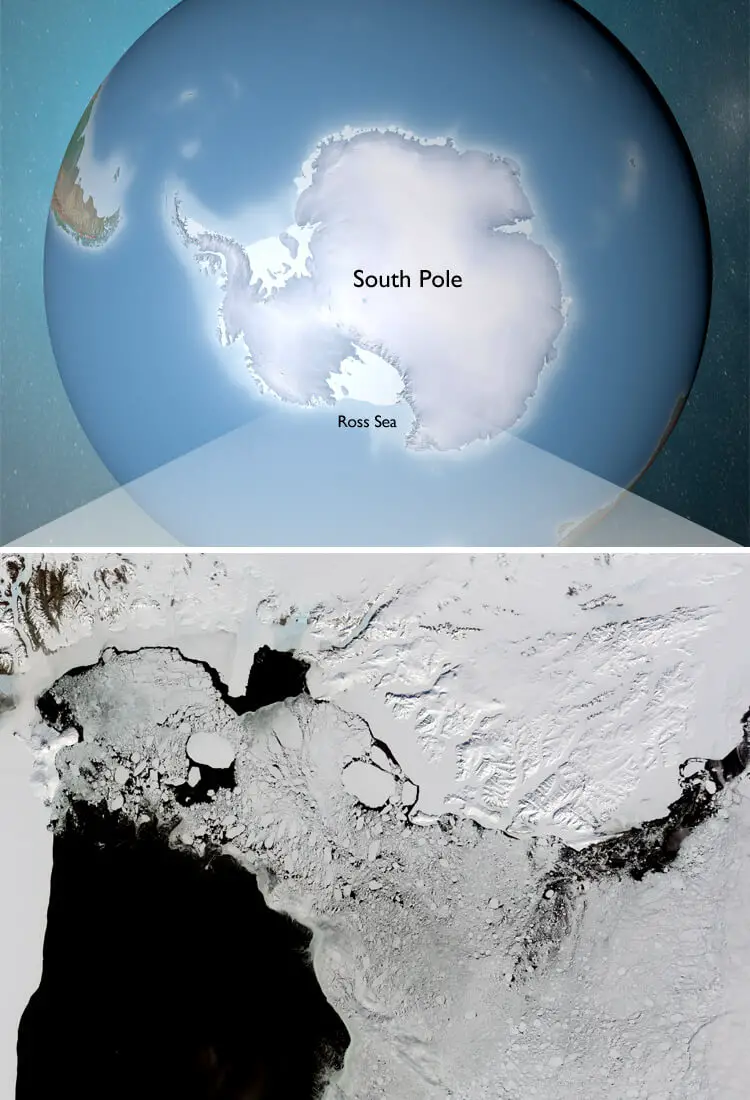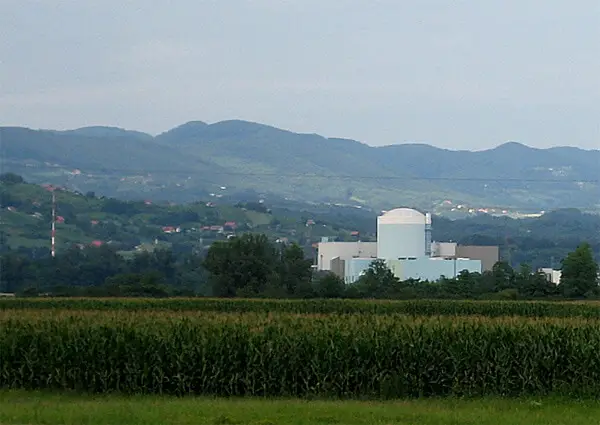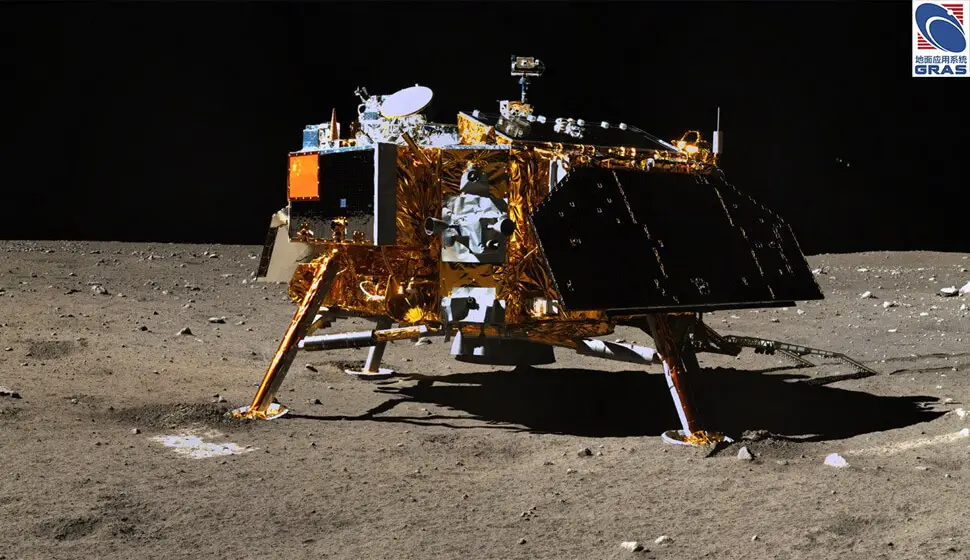
|
|
|
|
|
|
|
2043
The Ross Sea has lost 50% of its summer ice cover
The Ross Sea is a large bay of the Southern Ocean in Antarctica. Like much of the frozen continent, it had been gaining ice at the start of the 21st century. This was due to various factors including changes in wind speed, precipitation, salinity, ocean currents, air and water temperatures.
In subsequent decades, however, a rapid reduction of ice cover began to occur during the summer months as temperatures in the region soared, with corresponding changes in wind patterns and ocean currents. By 2043, half of the summer ice cover has been lost and is continuing to decline, now on track to decrease 56% by 2050 and 78% by 2100.**
The Ross Sea is critically important in regulating the production of Antarctica's sea ice overall. The decline now being witnessed therefore has long-term implications for the continent as a whole. This comes at a time when commercial interests are beginning to eye the potential for resource extraction, as the Antarctic Treaty is due for review in 2048.*
Marine life in this productive and once unspoiled ecosystem is also being negatively impacted. A number of important species are dependent on the ice during their life cycles, including crystal krill and Antarctic silverfish. Krill are a major food source for the Ross Sea's top predators – minke whales, crabeater seals, Adélie and Emperor penguins (the latter may go extinct by 2100, if trends continue).

Slovenia closes down its only nuclear power plant
The Krško Nuclear Power Plant is located in Krško, Slovenia. It was built between 1975-1983 as a joint venture by Slovenia and Croatia, which were at the time both part of Yugoslavia. With 730 megawatts of generation capacity, it provided more than one-quarter of Slovenia's and 15 percent of Croatia's power.
In 2008, a coolant leak was reported, triggering fears of a Chernobyl-style disaster and prompting an EU-wide alert. However, this turned out to be a false alarm. The incident resulted in a relatively large amount of media attention for what was a minor malfunction.
The planned retirement date for the plant was 14th January 2023. The decommissioning plan that was ratified by the Slovenian and Croatian parliaments scheduled the start of disassembly shortly after that, and the taking apart of the plant would last until 2036. An extension for 20 years – extending the plant lifetime to 14th January 2043 – was subsequently made to the Slovenian regulatory body (URSJV).*

The Chang'e-3 lander is shutting down
Chang'e-3 was a Chinese spacecraft launched in 2013. It was the country's first unmanned probe to touch down on the Moon's surface and included both a lander and rover. The landing site, in Mare Imbrium, was determined by topographic data from the previous Chang'e 1 and 2 orbiters.
On the surface, Chang'e-3 deployed a 140 kg (310 lb) rover named Yutu, which was designed to explore an area of 3 square kilometres (1.2 sq mi) during a three-month mission. Equipped with a digging tool, it performed analysis of soil samples. Using a radar on its underside, it also obtained the first direct measurements of the structure and depth of lunar soil down to 30 m (98 ft) and studied the lunar crust at several hundred metres' depth.
The lander, meanwhile, featured the first automated and remotely operated telescope to be deployed on another world. The thin exosphere and slow rotation of the Moon allowed for extremely long and uninterrupted views of targets and their light variation, improving a number of astronomical models. These observations included galaxies, active galactic nuclei, variable stars, binaries, novae, quasars and blazars, as well as the structure and dynamics of the Earth's plasmasphere. Three cameras installed on the lander – each facing in different directions – provided high-res panoramic imagery of the Moon's surface.* NASA's Lunar Reconnaissance Orbiter (LRO) took a photo of the landing site, in which the rover and lander were both clearly visible.*
With solar panels and a radioisotope heater unit (RHU) designed to last 30 years, Chang'e-3 was a very long-running mission. For comparison, NASA's Mars Science Laboratory had a lifespan of 14 years. While the rover stopped working in March 2015, the telescope on the stationary lander had enough power to operate until 2043. By this date, Chang'e-3 is finally shutting down.* Like the Apollo landing sites of the late 1960s and early 1970s, it earns a historic status and eventually becomes a tourist attraction when civilians are able to visit the Moon. Given the lack of atmosphere or weather conditions on the surface, it remains in a pristine state into the distant future.

Credit: Chinese Academy of Sciences
« 2042 |
⇡ Back to top ⇡ |
2044 » |
If you enjoy our content, please consider sharing it:
References
1 Study projects big thaw for Antarctic sea ice,
Virginia Institute of Marine Science:
http://www.vims.edu/newsandevents/topstories/ross_sea_thaw.php
Accessed 5th March 2014.
2 The effects of changing winds and temperatures on the oceanography of the Ross Sea in the 21st century,
Geophysical Research Letters:
http://dx.doi.org/10.1002/2014GL059311
Accessed 5th March 2014.
3 See 2048.
4 Decommissioning in Slovenia,
Jožef Stefan Institute:
http://www.iaea.org/OurWork/ST/NE/NEFW/WTS-Networks/IDN/idnfiles/Presentations-in-pdf-Necsa/Country_presentations/Slovenia.pdf
Accessed 11th November 2012.
5 Chang'e 3 Lunar panorama: Lander Terrain Camera,
360Cities:
https://www.360cities.net/image/lunar-panorama-change-3-lander
Accessed 11th June 2017.
6 NASA Images of Chang'e 3 Landing Site,
NASA:
https://www.nasa.gov/content/nasa-images-of-change-3-landing-site/
Accessed 11th June 2017.
7 China's telescope on the Moon is still working, and could do for 30 years,
gbtimes:
http://gbtimes.com/china/chinas-telescope-moon-still-working-and-could-do-30-years
Accessed 11th June 2017.
![[+]](https://www.futuretimeline.net/images/buttons/expand-symbol.gif)






